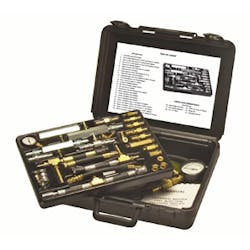Tips for test fuel pressure systems
When is an import not an import? Or, when is a domestic not a domestic? The answer to these questions gets confusing as domestic carmakers link up with their foreign counterparts in joint ventures. Unfortunately, this mixing of automotive descent has a major impact on checking fuel pressure. To keep things straight, connect according to the maker of the engine, not the chassis.
Why don't the imports provide this essential fitting? That’s debatable, but it's much healthier to establish a plan of action rather than dwell on why carmakers do some of the things they do. With that said, let's find out what it takes to connect a fuel pressure gauge to some popular makes from overseas.
PLEASE RELIEVE ME
Before we move on to the actual system connections, let's stop for a little refresher course on the two rules of fuel pressure safety. You may have heard these a thousand times, so let's make it one thousand and one:
Rule 1: Never, ever, open a fuel injection system without first relieving its fuel pressure!
Rule 2: Make sure there are no ignition sources for gasoline in your work area.
Granted, a Toyota injection system may not have as much pressure as a Bosch KE-Jet, it doesn't take much fuel to create a hazard. Always follow the manufacturer's guidelines for relieving fuel pressure on a specific car. Refer to your shop manuals for procedures on relieving fuel pressure for the cars you work on.
KEEP IT CLEAN
Always clean the area around the access point to help prevent dirt from entering the injection system. On some engines this will be easy, but on others where the access is at the cold-start injector hose (often buried under the intake manifold), it may be a good idea to spray-wash the engine first. Remember, any dirt you let in at this point can reach critical components like the injectors, fuel distributor and so on, because you're downstream from the fuel filter.
MAKING CONNECTIONS
Connection points for imported cars usually fall into
three different categories:
1) Series Connection—This type of connection requires the installation of a tee adapter
in series with the fuel supply line. Likely candidates for this type of hookup include Mazda,
Nissan, Mitsubishi and European imports with Bosch K- and KE-Jetronic fuel injection.
2) Hose-End Connection--This method applies mostly to older imports that have a flexible hose connecting to the cold-start injector.
3) Specialized Connection--The first two connections we discussed are generic because one adapter may fit several makes of cars. In some cases, you'll have to install a special adapter that only fits one make.
We'll give examples of these connections as we move on to applications.
TOYOTA TACTICS
Toyota (and Lexus) engines usually use a cold-start injector. With that in mind, Toyota engineers designate this spot as the access point for fuel pressure testing. You'll need a special test gauge or fittings to connect to these engines.
If you're using Toyota's gauge with the banjo fitting at the end, remove the steel line between the fuel rail and the cold-start injector. Connect the gauge to the fitting at the fuel rail. In some cases, you may need to connect at the outlet of the fuel filter.
If you're using an
aftermarket gauge and adapter hook-up, the connection is similar. Nevertheless, it's best
that you refer to the user's manual and follow the gauge maker's recommendations.
Honda helper
To tap into a Honda or Acura injection system, you'll need a special 6mm adapter. To install it, remove the 6mm bolt from the top of the fitting on the outlet line at the fuel filter. The filter mounts to the firewall at the right side of the engine compartment. Then, thread the adapter into place and tighten. Connect your gauge and follow the manufacturer's procedures and specifications for checking fuel pressure.
THREE OF A KIND
Connecting to most Nissan, Mazda and Mitsubishi models requires the same type of series connection. First, locate the fuel filter in the engine compartment. Then, disconnect the outlet line and connect a tee fitting between the outlet line and the fuel filter. Connect your gauge and take your readings.
K-KONNECTIONS
European imports with Bosch K-Jetronic or KE-Jetronic fuel injection differ slightly from electronic injection for connection and testing. Since these systems operate at higher pressures than most electronic systems, make sure your gauge reads a maximum of at least 630 kPa (90 psi). You also need a special adapter hose with shut-off valve and some other small adapters to connect to various makes of cars.
Tee into the control pressure line with the adapter. The control pressure line connects the fuel distributor and the control pressure regulator.
FINISHING TOUCH
After you're done testing and you've fixed what needed fixing, restore the injection system to its normal operating status. This also means tightening the lines and fittings to their proper torque values.
If any of the fittings use sealing washers, replace them. Installing the fittings without new sealing washers is like asking for a disaster.
Once everything's together, start the engine and check all fittings and connections for leaks. Then, and only then, release the car to the customer.
Okay, maybe it’s a little more trouble to tap into fuel injection systems from overseas, but it’s no big deal once you get the hang of it. With a little experience, it’ll ensure safety while shaving diagnostic time in the process.
